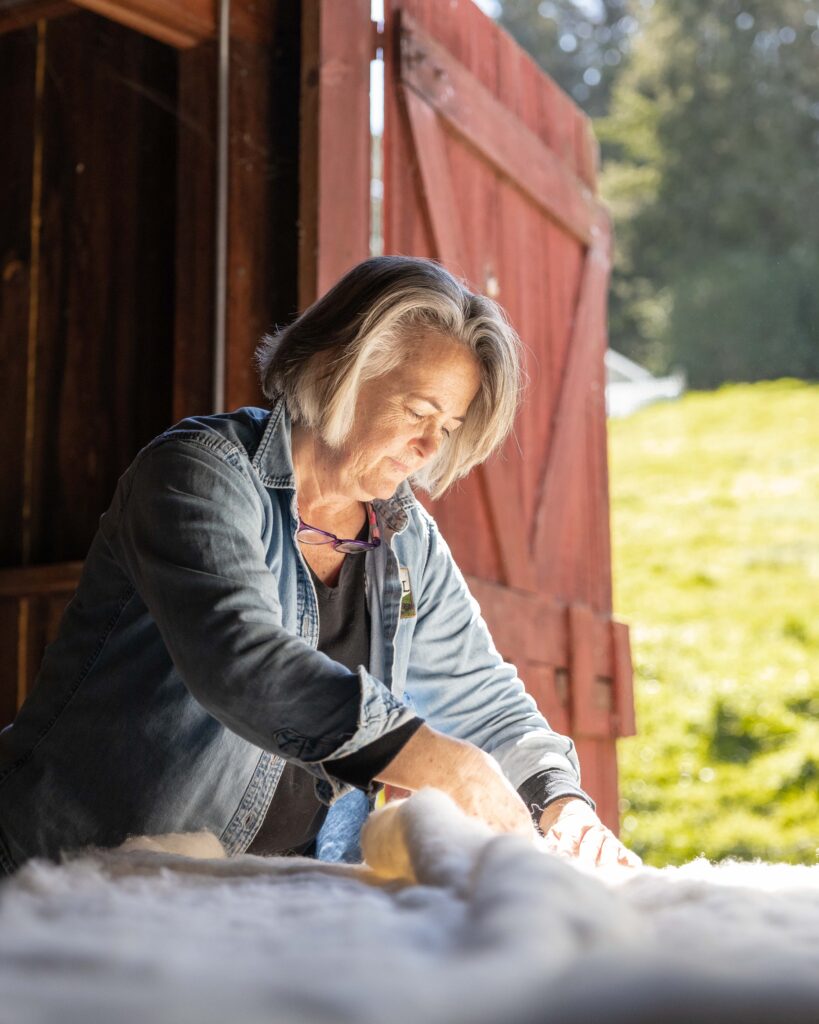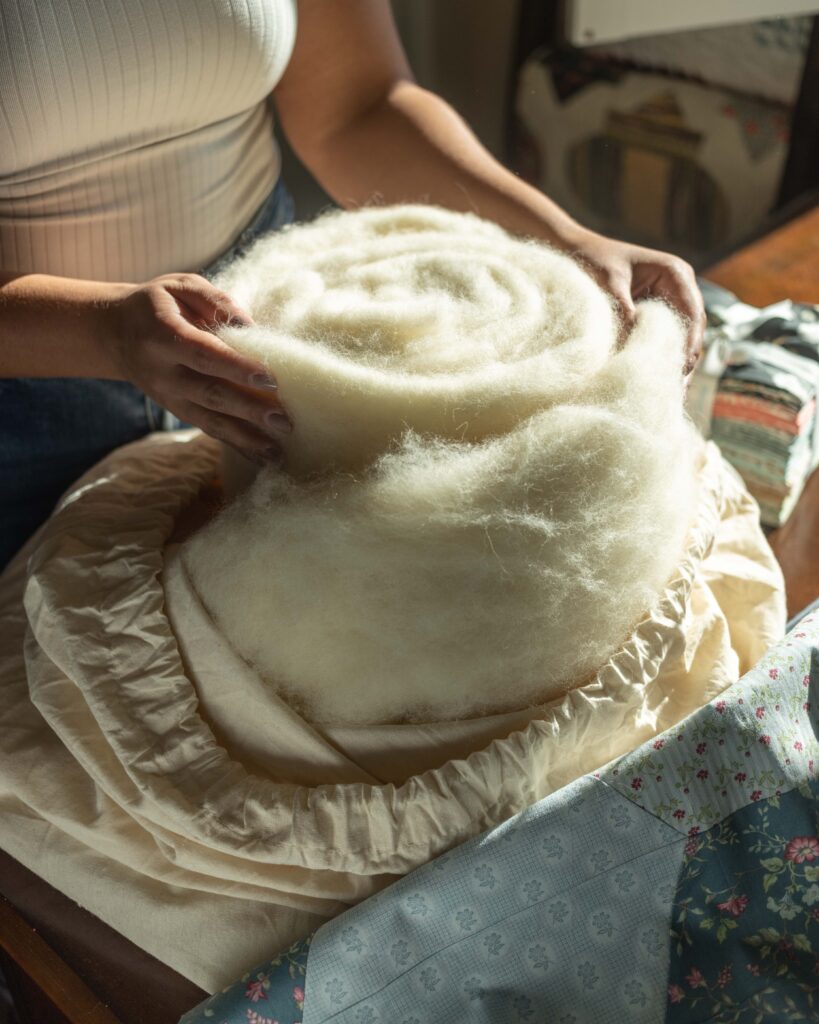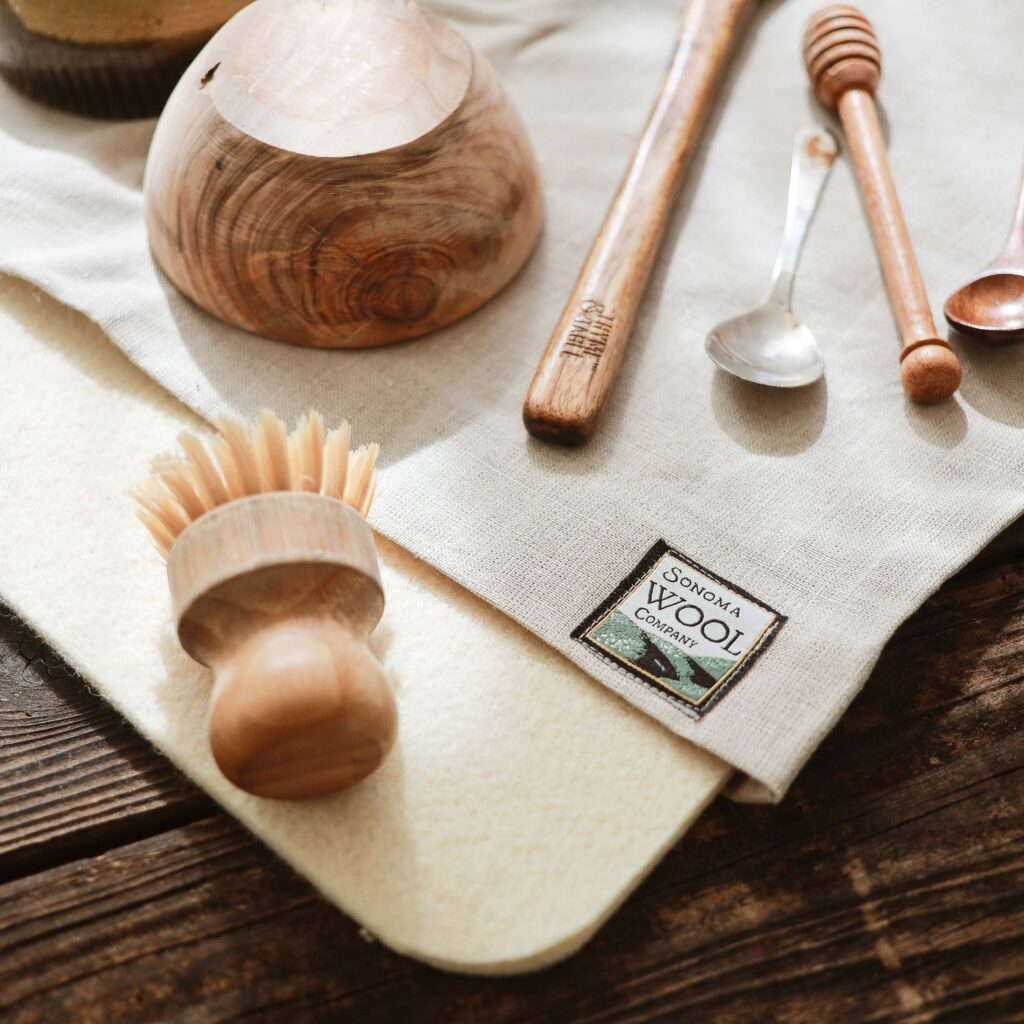We’re not the only company that loves wool and understands its advantages over synthetic, man-made products. Amy Chesnut and her team at Sonoma Wool Company are true wool experts and have built an amazing company that provides household products all made from this incredible fiber. We wanted to share their story with the Havelock community.
Hi Amy – Thanks for joining us! Please tell us a bit about your personal story and why you started Sonoma Wool Company.
Thanks, Phil, we appreciate your reaching out and all that you are doing at Havelock Wool! I created Sonoma Wool Company in a little red barn on a sheep ranch in Valley Ford, California, after spending some time learning about sheep and wool from a 4th generation rancher, Joe Pozzi. I had a 25-year career in land conservation and was assisting ranchers and forest landowners to figure out ways to place permanent protections on their working lands. In the process of getting to know these wonderful people, I learned a lot about sustainable practices to manage the land well. So, Sonoma Wool Company was created from a love of the land, for all that it provides – clean air, clean water, food, fiber, and habitat for wildlife (and us, too!). I realized that wool was such an incredible fiber, and could be used for everyday products, beyond apparel and carpeting. I have been dismayed about what microplastics and synthetics are doing to our environment, and felt that using wool, in place of plastics, would be ideal. I bought a cottage-industry-sized felting loom in 2013 and started experimenting with the wool and creating products. That fall, I bought a booth space at the local Heirloom Festival, and people loved the products. Whole Foods immediately started carrying our dryer balls, and we were up and running. This year we are celebrating our 10th anniversary!

How did you come up with your current products?
Simply put, I had a barn full of clean and carded wool and a new felting loom, so I took a look around the house to see what type of practical uses I could use wool for. The first product I made is now our signature product – the Wool Dish Drying mat. You use it next to your sink to protect your counter — in place of those microfiber dish mats. Wool absorbs up to 30% of its weight in water and naturally evaporates, so it is ideal for this purpose. It is now sold together with a Linen Sleeve, another ancient fiber, which absorbs and evaporates in a similar fashion.
As for our other products, we basically have noted what wool can do, and sought ways to use it throughout the home. The Ironing Board pad was designed from historical information on what was used prior to synthetics, and yes, it was wool. Some ideas have come from our customers… such as our Cat Mat. We had a number of customers tell us how much their cats love their dish mats, so bingo – we started making cat mats. The imperfect dryer balls, or “seconds”, are sold as Dog Toys, because of how much dogs love chasing the dryer balls around.
Wool is the best fiber to sleep in, on, and under, and our bedding collection is an extension of Joe Pozzi’s work since the 1990’s, when he developed a market for local wool to be used and sold to natural bedding manufacturers throughout the United States. Our bedding uses 100% all-natural wool batting, encased in 100% cotton. Our bedding collection includes comforters, mattress toppers and pillows in soft, medium and firm.

What is something that most people don’t know about the wool fiber?
Well, wool has been around for thousands of years and has been used for clothing, shelter, bedding and even medicinal purposes. (Compare that to the brief history of plastics which began in 1907, and came to be ubiquitous since the 1940’s). Our tagline is “Re-Discover The Wonders of Wool”, because we are only one or two generations away from the days when wool was regularly used for so many things. To start, wool is an absolutely incredible all-natural fiber because of all of its inherent qualities that have evolved over millennia as a way to maintain the health of the sheep. It is 100% natural, 100% renewable, it breathes, which enables it to maintain and regulate body temperature, is sustainable, anti-microbial, fire resistant, mold and mildew resistant, wicks away moisture and absorbs up to 30% of its weight in water, naturally evaporates, and at the end of its life it is biodegradable. Talk about being a part of the circular economy! We love showing people a magnified wool fiber to explain that each fiber has scales on it. It is these scales that enable the fiber to “breathe”, which makes wool do its magic. This is why it is perfect for insulation – as Havelock makes. And perfect for our Bedding Collection. What most people may not know about wool, is that all wool is not the same. We source our wool from ranchers throughout the United States, and it is washed (scoured), carded, felted and used in our products – all through a chain of small family businesses here in America. So, when folks buy our products they can feel comfortable that they are supporting a United States supply and manufacturing chain. There are a few other things that we do not do to our wool – we do not carbonize our wool, which is a chemical process that burns out the organic matter (think grasses from the pastures). The wool we use goes through multiple combing processes to remove the veg matter. The other thing we do not do is to treat the wool with any type of polymer before using them in our products. Some manufacturers use a superwash to coat the scales of the wool fiber, so that the item may be washed in a machine without worry of felting or shrinking. We prefer to use the wool in its naked state – and simply explain to our customers that our items need to spot cleaned, hand washed and aired out periodically.

Wool is more expensive than most synthetic fibers. How do you compare the true cost to competing products?
This is true. I like to point out the hidden costs of “fast fashion” or inexpensive synthetic items. Damage to one’s health, the health of their home, and of course the health of the planet by using and wearing synthetic materials is one hidden cost. When we use synthetic fibers, the microfibers of the material escape into the air and water, and we breathe them in, and ultimately consume them as part of the natural food chain. Unfortunately, there is no way to escape this in today’s world, but we can minimize our exposure to synthetics by using all-natural materials. Wool also lasts a lot longer than synthetic fibers. So, another way to look at using wool, is more of an investment. I have customers who are still using the Dish Drying Mat they purchased 10 years ago. And, of course, our bedding and blankets are heirloom quality that will certainly last generations.
I also like to point out, that when people choose Sonoma Wool Company products, they are supporting family businesses throughout the United States. We like to help people understand and connect the dots between supporting family ranches and protecting the land for all of the benefits it provides. We have a place in our shop in Brewster, where folks can touch and feel the different stages of wool production, so they see what it takes to get the wool from the sheep to the comforter, or ironing board pad, or cat mat. There are many, many steps, and relative costs involved to get to the final product. Ultimately, if people continue to purchase wool products, the industry will be able to scale back up to where it once was a century ago, and the relative costs of production should decrease accordingly.
For all those quilters out there, what are the benefits of using your wool batting?
First and foremost, wool breathes, so if you are making a quilt for your bed and for sleeping under, the wool batting will keep you warm in the winter and cool in the summer. Wool’s soft drape is also excellent for smaller quilts that you would like to wrap around yourself. If you happen to be making a quilt as a wall-hanging or artwork, wool has greater elasticity than cotton batting. It is springy, and bounces back. So, you can bring your artwork from Quilt Show to Quilt Show without worrying about permanent creases in your quilt. A wool fiber can bend more than 20,000 times before breaking (versus a cotton fiber which only lasts about 6,200 times). Wool also has a high strong loft, and maintains its loft over time. Due to this, wool provides excellent stitch definition, and we recommend our batting for a 3” quilting distance or less. As an all-natural product, without scrims or resins to resist your needles, the wool batting is great for both hand and machine quilting. And of course, wool is durable and long lasting – when working on heirloom projects for your family, choosing wool will ensure a piece that will last for generations.
Do you see other areas where wool can replace existing consumer products?
We are constantly adding products to our line – check out our new Wool Coasters. And have so many ideas to come – just wish we had more hours in the day. We also reach out to other wool-loving companies to see if they would like us to carry their creative and innovative products, such as Wild Valley Farms Wool Pellets. And we love to hear from our customers, who toss us new ideas every now and then! We even have a few ideas on how we can collaborate with you, Phil, and Havelock Wool!


I’m so happy to learn of your company! I use nontoxic products in my home.